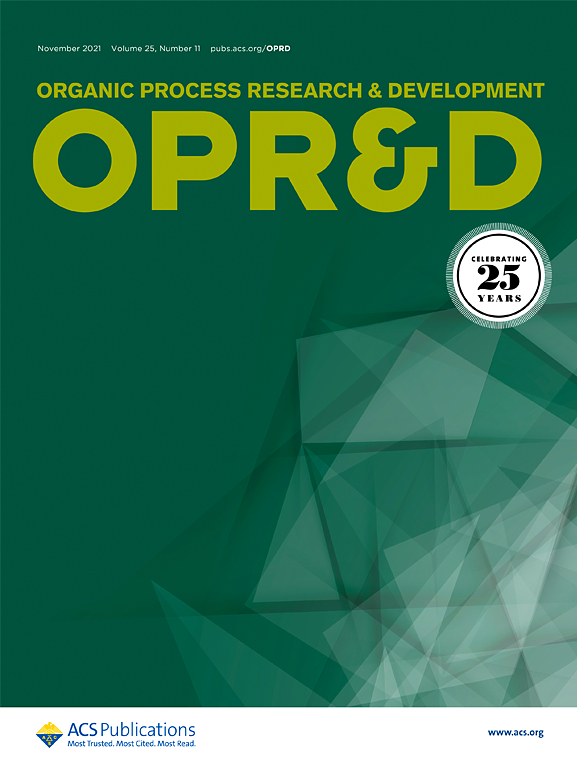Novel and Cost-Effective Manufacturing Process Development of Daprodustat
IF 3.1
3区 化学
Q2 CHEMISTRY, APPLIED
引用次数: 0
Abstract
Daprodustat is a hypoxia-inducible factor prolyl hydroxylase (HIF-PH) inhibitor indicated for treating anemia in patients with chronic kidney disease (CKD). This study describes a novel, efficient, and robust kilogram-scale manufacturing process for daprodustat starting from commercially available malonic acid by implementing quality by design (QbD) principles. A novel synthetic approach was adopted for the synthesis of methyl (1,3-dicyclohexyl-6-hydroxy-2,4-dioxo-1,2,3,4-tetrahydropyrimidine-5-carbonyl)glycinate by avoiding the use of ethyl isocyanatoacetate and replacing it with methyl glycinate and CDI. To our delight, we achieved a throughput of 76% with over 99% purity for daprodustat, compared to the previously reported throughput of 52%. This approach has enabled us to develop a more environmentally friendly process for synthesizing daprodustat than the prior method.

新型高效生产工艺的开发
达普司他是一种缺氧诱导因子脯氨酸羟化酶(HIF-PH)抑制剂,用于治疗慢性肾脏疾病(CKD)患者的贫血。本研究通过实施质量设计(QbD)原则,描述了一种新颖、高效、稳健的公斤级生产工艺,从市售的丙二酸开始。以甘氨酸甲酯和CDI代替异氰酸酯乙酯,采用新的合成方法合成了(1,3-双环己基-6-羟基-2,4-二氧基-1,2,3,4-四氢嘧啶-5-羰基)甘氨酸甲酯。令我们高兴的是,我们在纯度超过99%的情况下获得了76%的产量,而之前报道的产量为52%。这种方法使我们能够开发出一种比以前的方法更环保的合成达吡司他的方法。
本文章由计算机程序翻译,如有差异,请以英文原文为准。
求助全文
约1分钟内获得全文
求助全文
来源期刊
CiteScore
6.90
自引率
14.70%
发文量
251
审稿时长
2 months
期刊介绍:
The journal Organic Process Research & Development serves as a communication tool between industrial chemists and chemists working in universities and research institutes. As such, it reports original work from the broad field of industrial process chemistry but also presents academic results that are relevant, or potentially relevant, to industrial applications. Process chemistry is the science that enables the safe, environmentally benign and ultimately economical manufacturing of organic compounds that are required in larger amounts to help address the needs of society. Consequently, the Journal encompasses every aspect of organic chemistry, including all aspects of catalysis, synthetic methodology development and synthetic strategy exploration, but also includes aspects from analytical and solid-state chemistry and chemical engineering, such as work-up tools,process safety, or flow-chemistry. The goal of development and optimization of chemical reactions and processes is their transfer to a larger scale; original work describing such studies and the actual implementation on scale is highly relevant to the journal. However, studies on new developments from either industry, research institutes or academia that have not yet been demonstrated on scale, but where an industrial utility can be expected and where the study has addressed important prerequisites for a scale-up and has given confidence into the reliability and practicality of the chemistry, also serve the mission of OPR&D as a communication tool between the different contributors to the field.

 求助内容:
求助内容: 应助结果提醒方式:
应助结果提醒方式:


